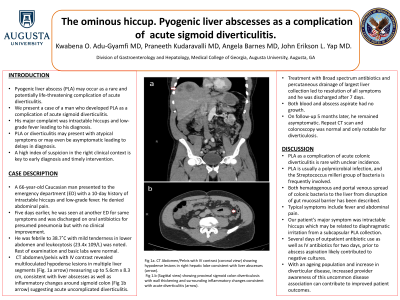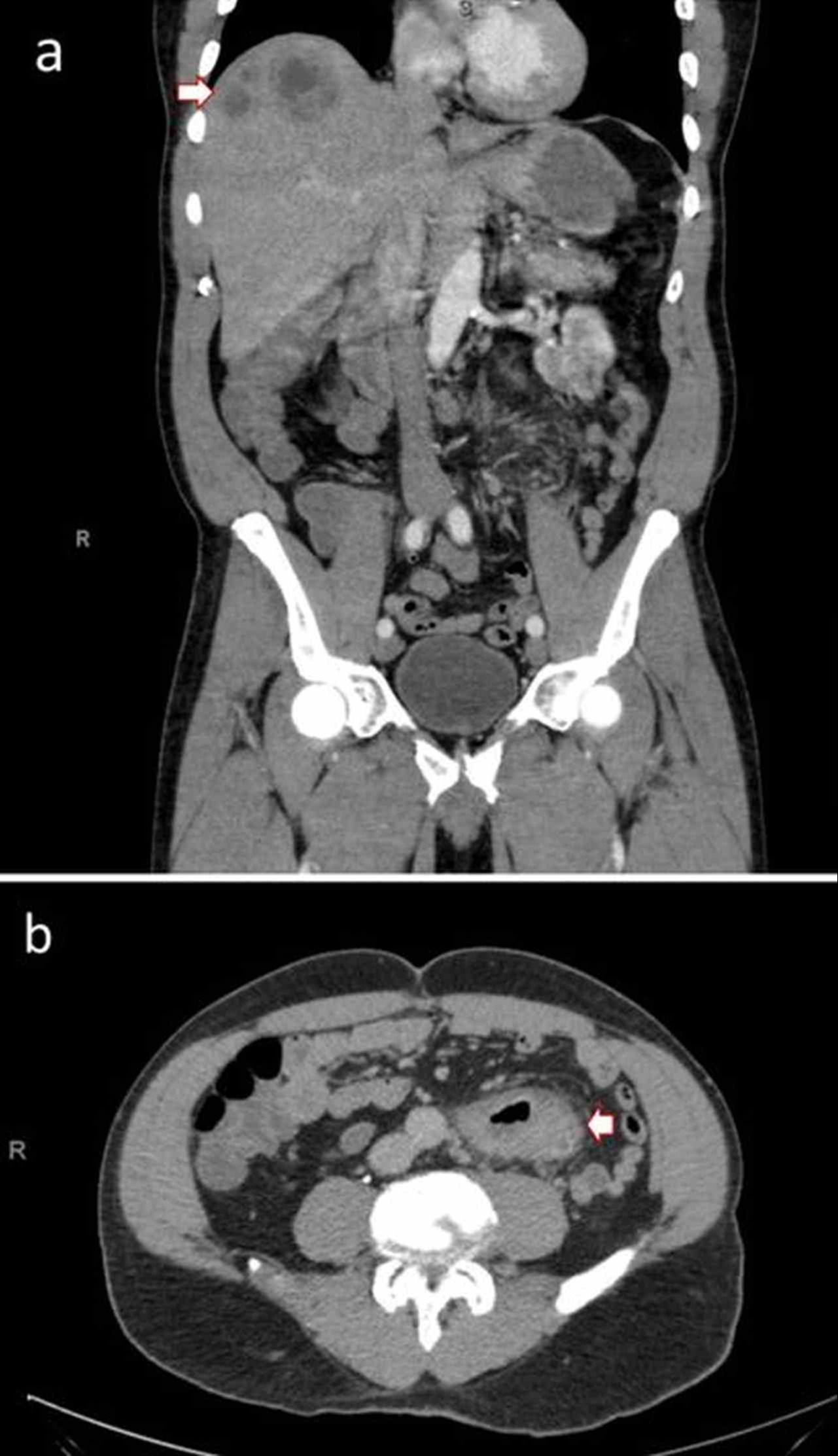Back


Poster Session B - Monday Morning
Category: Liver
B0550 - The Ominous Hiccup: Pyogenic Liver Abscesses as a Complication of Acute Sigmoid Diverticulitis
Monday, October 24, 2022
10:00 AM – 12:00 PM ET
Location: Crown Ballroom

Has Audio

Kwabena O. Adu-Gyamfi, MBChB
Medical College of Georgia - Augusta University
Augusta, GA
Presenting Author(s)
Kwabena O. Adu-Gyamfi, MBChB1, Praneeth Kudaravalli, MD2, Angela Barnes, BSc, MD3, John Erikson L. Yap, MD4
1Medical College of Georgia - Augusta University, Augusta, GA; 2Augusta University Medical Center, Augusta, GA; 3Medical College of Georgia at Augusta University, Augusta, GA; 4Augusta University Medical College of Georiga, Augusta, GA
Introduction: Pyogenic liver abscess (PLA) may occur as a rare and potentially life-threatening complication of acute diverticulitis. We present a case of a man who developed PLA as a complication of acute sigmoid diverticulitis. His major complaint was intractable hiccups and low-grade fever leading to his diagnosis. PLA or diverticulitis may present with atypical symptoms or may even be asymptomatic leading to delays in diagnosis. A high index of suspicion in the right clinical context is key to early diagnosis and timely intervention.
Case Description/Methods: A 66-year-old Caucasian man presented to the emergency department (ED) with a 10-day history of intractable hiccups and low-grade fever. He denied abdominal pain. Five days earlier, he was seen at another ED for same symptoms and was discharged on oral antibiotics for presumed pneumonia but with no clinical improvement. He was febrile to 38.7˚C with mild tenderness in lower abdomen and leukocytosis (23.4x 109/L) was noted. Rest of examination and basic labs were normal. CT abdomen/pelvis with IV contrast revealed multiloculated hypodense lesions in multiple liver segments (Fig. 1a) measuring up to 5.6cm x 8.3 cm, consistent with liver abscesses as well as inflammatory changes around sigmoid colon (Fig 1b) suggesting acute uncomplicated diverticulitis. Treatment with Broad spectrum antibiotics and percutaneous drainage of largest liver collection led to resolution of all symptoms and he was discharged after 7 days. Both blood and abscess aspirate had no growth. Follow-up 5 months later, he remained asymptomatic. Repeat CT scan and colonoscopy was normal and only notable for diverticulosis.
Discussion: PLA as a complication of acute colonic diverticulitis is rare with unclear incidence. PLA is usually a polymicrobial infection, and the Streptococcus milleri group of bacteria is frequently involved. Both hematogenous and portal venous spread of colonic bacterial to the liver from disruption of gut mucosal barrier has been described. Typical symptoms include fever and abdominal pain. Our patient’s major symptom was intractable hiccups which may be related to diaphragmatic irritation from a subcapsular PLA collection. Several days of outpatient antibiotic use as well as IV antibiotics for two days, prior to abscess aspiration likely contributed to negative cultures. With an ageing population and increase in diverticular diseases, increased provider awareness of this uncommon disease association can contribute to improved patient outcomes.

Disclosures:
Kwabena O. Adu-Gyamfi, MBChB1, Praneeth Kudaravalli, MD2, Angela Barnes, BSc, MD3, John Erikson L. Yap, MD4. B0550 - The Ominous Hiccup: Pyogenic Liver Abscesses as a Complication of Acute Sigmoid Diverticulitis, ACG 2022 Annual Scientific Meeting Abstracts. Charlotte, NC: American College of Gastroenterology.
1Medical College of Georgia - Augusta University, Augusta, GA; 2Augusta University Medical Center, Augusta, GA; 3Medical College of Georgia at Augusta University, Augusta, GA; 4Augusta University Medical College of Georiga, Augusta, GA
Introduction: Pyogenic liver abscess (PLA) may occur as a rare and potentially life-threatening complication of acute diverticulitis. We present a case of a man who developed PLA as a complication of acute sigmoid diverticulitis. His major complaint was intractable hiccups and low-grade fever leading to his diagnosis. PLA or diverticulitis may present with atypical symptoms or may even be asymptomatic leading to delays in diagnosis. A high index of suspicion in the right clinical context is key to early diagnosis and timely intervention.
Case Description/Methods: A 66-year-old Caucasian man presented to the emergency department (ED) with a 10-day history of intractable hiccups and low-grade fever. He denied abdominal pain. Five days earlier, he was seen at another ED for same symptoms and was discharged on oral antibiotics for presumed pneumonia but with no clinical improvement. He was febrile to 38.7˚C with mild tenderness in lower abdomen and leukocytosis (23.4x 109/L) was noted. Rest of examination and basic labs were normal. CT abdomen/pelvis with IV contrast revealed multiloculated hypodense lesions in multiple liver segments (Fig. 1a) measuring up to 5.6cm x 8.3 cm, consistent with liver abscesses as well as inflammatory changes around sigmoid colon (Fig 1b) suggesting acute uncomplicated diverticulitis. Treatment with Broad spectrum antibiotics and percutaneous drainage of largest liver collection led to resolution of all symptoms and he was discharged after 7 days. Both blood and abscess aspirate had no growth. Follow-up 5 months later, he remained asymptomatic. Repeat CT scan and colonoscopy was normal and only notable for diverticulosis.
Discussion: PLA as a complication of acute colonic diverticulitis is rare with unclear incidence. PLA is usually a polymicrobial infection, and the Streptococcus milleri group of bacteria is frequently involved. Both hematogenous and portal venous spread of colonic bacterial to the liver from disruption of gut mucosal barrier has been described. Typical symptoms include fever and abdominal pain. Our patient’s major symptom was intractable hiccups which may be related to diaphragmatic irritation from a subcapsular PLA collection. Several days of outpatient antibiotic use as well as IV antibiotics for two days, prior to abscess aspiration likely contributed to negative cultures. With an ageing population and increase in diverticular diseases, increased provider awareness of this uncommon disease association can contribute to improved patient outcomes.

Figure: Fig 1. CT Abdomen/Pelvis with IV contrast (coronal view) showing hypodense lesions in right hepatic lobe consistent with liver abscesses (Fig 1a). Sagittal view CT showing proximal sigmoid colon diverticulosis with wall thickening and surrounding inflammatory changes consistent with diverticulitis (Fig 1b).
Disclosures:
Kwabena Adu-Gyamfi indicated no relevant financial relationships.
Praneeth Kudaravalli indicated no relevant financial relationships.
Angela Barnes indicated no relevant financial relationships.
John Erikson Yap indicated no relevant financial relationships.
Kwabena O. Adu-Gyamfi, MBChB1, Praneeth Kudaravalli, MD2, Angela Barnes, BSc, MD3, John Erikson L. Yap, MD4. B0550 - The Ominous Hiccup: Pyogenic Liver Abscesses as a Complication of Acute Sigmoid Diverticulitis, ACG 2022 Annual Scientific Meeting Abstracts. Charlotte, NC: American College of Gastroenterology.
